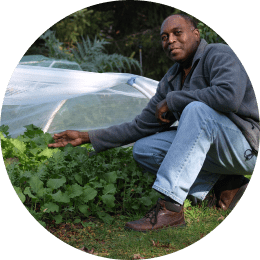Winter Vegetables are the cold hardy varieties that don’t flinch at the arrival of fall frosts, and have no problem withstanding a moderate amount of freezing weather. In fact, some winter vegetables can survive to enjoy the warmth of spring and continue producing harvests for the crafty gardener.
Here’s a list of my favorite cold hardy winter vegetables for home garden production:
First on the list is Kale because it’s nutritious, delicious, and one of the hardiest plants in the garden. Add to that the large number of varieties and the ornamental qualities of this plant and you can’t go wrong with growing kale in the fall vegetable garden.
 Collards make the list right up there with the kales. Just as cold hardy, collards also flourish during the high temperatures of summer. It’s a cinch to nurture collards, especially the variegated variety, right through the winter.
Collards make the list right up there with the kales. Just as cold hardy, collards also flourish during the high temperatures of summer. It’s a cinch to nurture collards, especially the variegated variety, right through the winter.
Brussels Sprouts not only stand tall during the fall, but frigid temperatures only serve to make the sprouts sweeter and more flavorful. Pick and enjoy before hard freezes set in, or pull the plant and hang in an unheated area to stretch out the harvest.
Spinach is a winter vegetable that grows well under the cold and low light conditions of autumn. With a snow cover or light mulch to provide protection you should have no problem resuming the harvest of fresh spinach when spring arrives.
Leeks tolerate repeated freezing and thawing and your biggest challenge will be getting them out of the garden after the ground has frozen. They require a very long growing season, so plant in early spring for fall harvests.
Mache isn’t well known or appreciated by many gardeners, but can provide you with tasty, lettuce-like greens well into the fall.
Did I mention Lettuce, yes it qualifies as a winter vegetable. It enjoys cool, fall weather, and both heading and leaf varieties can be planted during late summer for fall production. I’ve grown a variety called “winter lettuce” that can be planted thickly during late fall to form two inch rosettes that will over winter and produce large heads of delicious lettuce the following spring.
Parsnips are included on the list because cold temps really bring out their best flavor and sweetness. Planted in early spring they will grow through summer, survive the winter unprotected and can be harvested right through the following spring.
Garlic isn’t a winter vegetable in the sense that you can harvest it during the fall season like all the others. I’m including it here because it’s one of my favorite  plants, and in many areas you’ll get the best results growing garlic from a fall planting.
plants, and in many areas you’ll get the best results growing garlic from a fall planting.
That’s the list, so if you’re looking to extend your growing season into the colder months of the year try growing these winter vegetables for your gardening and dining enjoyment. For more gardening tips and information, you can subscribe to my free gardening newsletter at: http://www.mygardeningsecrets.com/optin.html.



 Address:
Address: EMAIL:
EMAIL: Telephone:
Telephone: